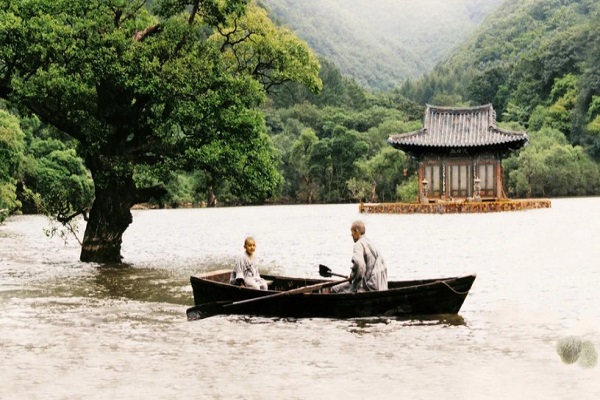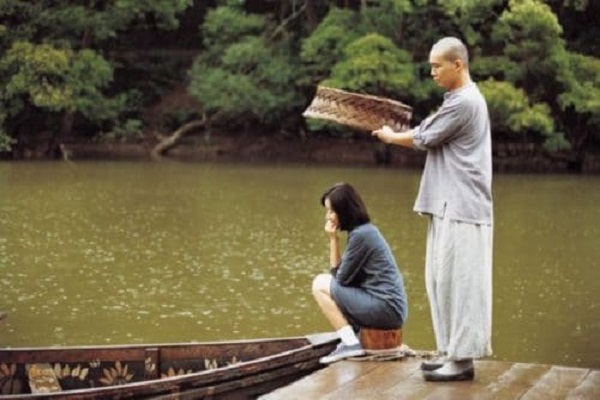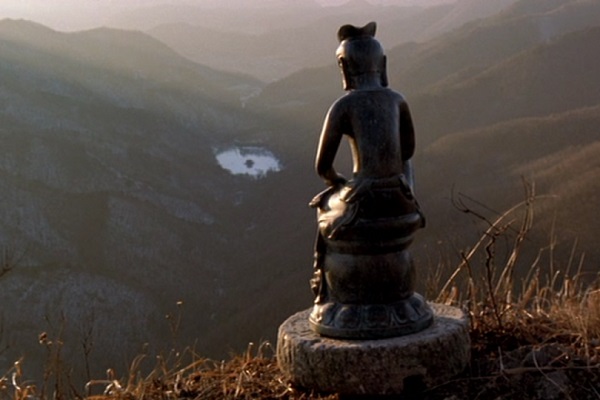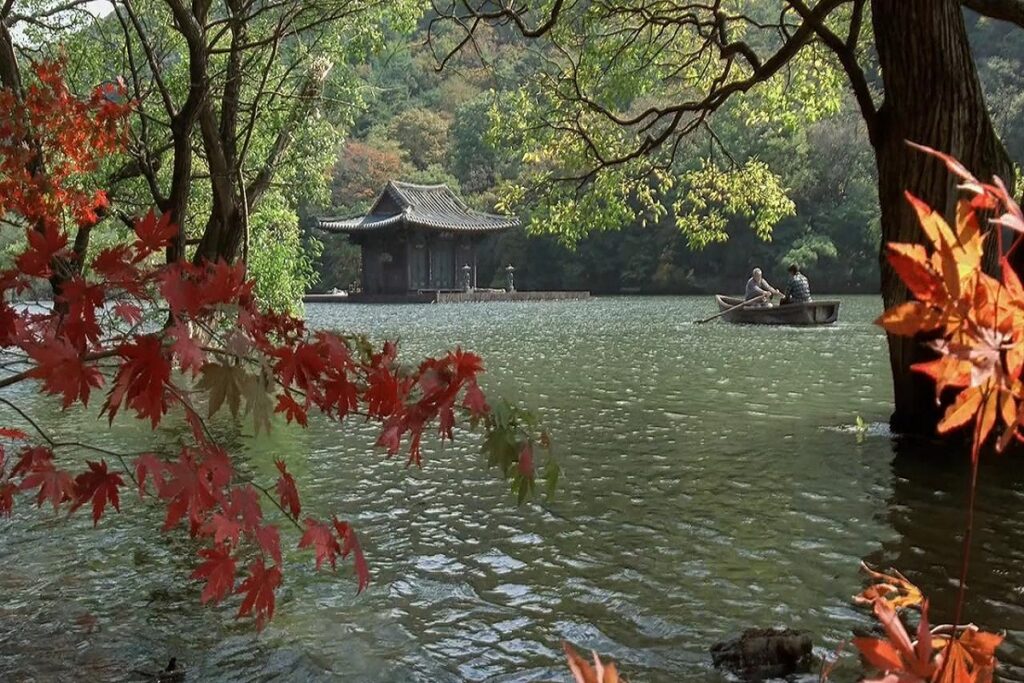Kim Ki-duk’s Spring, Summer, Fall, Winter… and Spring is one of the most spiritual, philosophical, soothing, and beautiful films ever. Even though the film is based on the premises of Buddhism, anybody from any religion can feel the pulse of the film. So, this is a universal film. It is set in a Buddhist monastery in the middle of a pristine lake surrounded by hills covered with green forest. Spring, Summer, Fall, Winter… and Spring features a Buddhist monk or master and his disciple across spring, summer, fall, winter, and again spring in that monastery. However, the cycle of seasons is not continuous here as there is a ten-to-twenty years difference between consecutive seasons. Hence, filmmaker Kim Ki-duk portrays the cycle of life in the film. The entire film is depicted through multiple Buddhist principles. But, he does not preach any religion here. He only shows that life is beautiful no matter how strongly the negative forces affect us. Amid, numerous obstacles, Spring, Summer, Fall, Winter… and Spring is all about the celebration of life.
The film revolves around the lifecycle of a Buddhist monk and his disciple. Even though the cycle is portrayed through the cycle of seasons spring, summer, fall, winter, and spring again, there are gaps of ten to twenty years in between the consecutive seasons. So, the lifecycle of both the master and his disciple changes when the season changes. In the spring, the master and his novice disciple pass their days by meditating inside the floating monastery. The disciple goes to the other side of the lake to collect herbs by an old rowboat. One day, while collecting herbs, he sees a fish, frog, and snake, and ties a stone to each of them. He giggles while tying the stones failing to feel their pain. His master follows him and sees his activities from behind. He ties a stone to his disciple while he is asleep. When he gets up in the morning, he realizes his mistake. The master instructs him to untie the stones from all three animals, and if any of them has already died, he will have to bear the pain in his heart throughout his life. The young monk returns there and sees the fish and the snake have already died. He now realizes his mistake, feels tormented, and sobs profusely. His master sees his repentance from behind.

Now the season changes to summer and the life cycle of the master and his disciple also advances significantly. The disciple has reached his teenage years and his master has grown much older. A rooster, which is a symbol of desire and attachment in Buddhism, is a part of the monastery now. A lady happens to visit the monastery with her sick daughter to get her healed. The young disciple falls in love with the girl. He gropes her breasts, takes her to the other side of the lake by the rowboat, and then has sex with her. They continue the sexual activity for a few days and then get caught by the master while asleep in the floating boat. The master warns him that lust awakens possessiveness and possessiveness leads to murder. The girl is no longer allowed in the monastery. The master takes her in the boat, rows across the lake, and leaves her in front of the door. The young disciple misses her badly and can’t stay without her. The following night, he leaves the monastery with the rooster and the Buddha statue.
The season now changes to fall. The young disciple is in trouble now after murdering his wife. He returns to the monastery with the Buddha statue and tries to commit suicide as per the Buddhist rituals. The master beats him severely as suicide is a sin. He tells his disciple to curve the Heart Sutra on the wooden floor of the monastery as it will soothe his anger. He shaves his head, wears the holy garment, and starts curving the Heart Sutra on the wooden floor of the monastery. Soon, two detectives arrive there but allow him to continue with curving as per his master’s request. After finishing curving, he falls asleep. The detectives paint the letters with orange, green, blue, and purple colors. When the disciple awakes, the detectives take him away. The master builds a pyre on the boat, sits on it, seals his mouth, ear, and nose with paper, and then sets the pyre on fire. A snake leaves the boat and swims across the lake to the monastery.

Now comes the winter. The young disciple is now in his middle age. He returns to the monastery which has been uninhabited since his master’s demise. He digs out his master’s teeth and sarira from the boat, builds a statue of Lord Buddha under a water stream, and then wraps the Sarira around the statue with a red cloth. The monk finds out a book about Buddhist physical exercises and starts practicing in that freezing atmosphere. A woman, whose face is covered with a shawl, comes to the monastery with her baby son in her lap. She leaves her son there and tries to flee during the night when she accidentally falls down a hole in the lake. The monk discovers her body the next morning and starts taking care of the kid. The monk ties the grinding stone to his body with a rope, takes the Buddha statue in his hands, and starts climbing to the summit of the tallest hill there. While passing through the forest, he sees the frog, the fish, and the snake whom he tormented earlier. He reaches the summit, places the Buddha statue on the circular grinder, and starts praying looking at the monastery from a distance.
The spring arrives again. The novice disciple tortures the turtle in the monastery, goes to the forest, and puts stones forcibly in the mouths of a frog, fish, and snake just like his master did. The cycle repeats. In the last scene, the Buddha statue is seen on the summit with a bird’s eye view of the monastery on the lake from a distance.
The most important point that filmmaker Kim Ki-duk establishes in Spring, Summer, Fall, Winter… and Spring is that life is beautiful. Amid agony, suffering, killing, and violence, he celebrates the quintessential essence of life. The film is filled with breathtaking natural beauty throughout. The calm and quiet floating monastery is situated in the middle of a pristine lake surrounded by hills covered with green forest. The atmosphere is so serene, beautiful, and meditative that it generates addiction in viewers’ minds and hearts. We fall in love with the monastery and its inhabitants. We visit the monastery in our imagination and meditate there. There will be pain, crime, and violence in this world like the way the novice monk ties stones to the fish, frog, and snake or he kills his wife in middle age. Attaining absolute peace may not be possible practically in this world. However, these negative forces should never surpass the beauty and virtues of life. We should always be hopeful for a bright future. The only way to achieve a beautiful and peaceful world is through optimism.

Another important aspect of Spring, Summer, Fall, Winter… and Spring is the Cycle of Life or Bhavachakra in Buddhism. Much like the seasons of nature, the Cycle of Life changes continuously and is never static. In Spring, Summer, Fall, Winter… and Spring, filmmaker Kim Ki-duk brilliantly draws an analogy between the Cycle of Seasons and the Cycle of Life. Seasons change from spring to winter through summer and fall. In the same way, the Cycle of Life changes from childhood to old age through youth and middle age. In the film, the life cycle of both the master and his disciple changes, and the change is reflected through the change of seasons. The disciple is a novice monk in spring, a lover in summer, a wife-killer in fall, and a middle-aged monk in winter. Spring starts again when the abandoned baby turns into a novice monk and tortures the animals in the same way his master did during his spring. The Cycle of Life or Bhavachakra is represented in the film by the circular grinder that the monk drags to the highest hill summit in the last scene. The film also features a rooster, which represents attachment in Bhavachakra, and a snake, which represents anger.
In Spring, Summer, Fall, Winter… and Spring, filmmaker Kim Ki-duk brilliantly and vividly shows the Buddhist principles of Karma, Samsara, and Nirvana. The novice monk in spring tortures the frog, fish, and snake. The fish and snake ultimately are killed. In the fall when he is young, he kills his wife. As per Buddhism, Hinduism, and Jainism, one cannot escape from his crimes and misdeeds. His future will be dependent on his past activities. If he creates pain for others, he will also be tormented. Karma is true, eternal, and universal. The only way to achieve Nirvana or Mukti or redemption or liberation is through the way of detachment of the soul from the worldly being, and that can only be achieved through the way of the beloved Lord. In the last scene, the middle-aged monk carries the Buddha statue, drags the circular grinder to the topmost summit of the surrounding hills, and starts meditating there. He follows the path to Nirvana to redeem himself from his past activities. Samsara or the family life creates worldly attachments. Nirvana or the absolute liberation of the soul is impossible with worldly attachments. In summer when the disciple monk is in his youth, he falls in love with the girl and eventually engages in sexual activities with her. His master warns him that lust awakens possessiveness and possessiveness leads to murder. His words come true in the fall when he kills his wife. In winter, he returns to the monastery again in his middle age and starts following the path of meditation and then Nirvana.
Spring, Summer, Fall, Winter… and Spring is one of the most beautiful films in the history of cinema. The most important aspect of the film is Baek Dong-hyun’s brilliant cinematography. His camera efficiently captures the breathtaking natural beauty of the pristine lake surrounded by hills covered with lush green forest. The cinematography is so beautiful that each screen capture can form a beautiful portrait. Each season looks serene, and beautiful, and gets its aura through Dong-hyun’s camera. Shots in winter look so beautiful as if the surrounding is filled with heavenly bliss. Dialogues are almost stripped off the screenplay. However, the emotions and actions of the actors portray the essence of the scenes. Park Ji-woong’s music complements the spiritual and philosophical theme of the film. The Arirang song used in the scene when the middle-aged monk climbs the hill enriches it with a supreme level of Buddhist principles. The actors including Kim Ki-duk portray their roles as per the demand of the scenes. O Yeong-su portrays the role of the master with utmost calmness and restraint. Another important task brilliantly executed in the film is the set design of the floating monastery on Jusanji Lake in South Korea.
